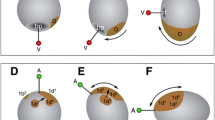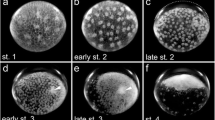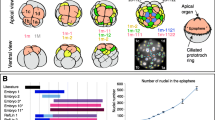Summary
Spirally cleaving embryos in which the first two cleavages generate four equal-sized blastomeres remain radially symmetrical along their animal-vegetal axis until the interval between third and fourth quartet formation. At this time animal micromeres and vegetal macromeres contact each other as they elongate and occlude the central, fluid-filled cleavage cavity. The overlying micromeres focus their contacts onto one of the four macromeres, the presumptive 3D macromere, as it elongates to a central position within the embryo. We tested the hypothesis that this animal-vegetal interaction was causally involved in the determination of the symmetry properties in both the animal and vegetal hemispheres by reversibly inhibiting animal-vegetal contact at the 24 cell stage with cytochalasin-B. Embryos remained hollow throughout the treatment period and animal-vegetal interaction did not occur. After treatment, blastomere elongation occurred but no D quadrant macromere appeared and the vegetal hemisphere remained radialized. On the basis of cleavage and ciliation patterns of first quartet derivatives, treated embryos remained fully or partially radialized, showing a strong tendancy to develop as ventral quadrants. These results show that the quadrants of this equal-cleaving spiralian are not definitively determined until after the 24 cell stage and that animal-vegetal interaction is required for D quadrant determination. The mechanisms of symmetrization in the animal and vegetal hemispheres of equal-cleaving spiralians is also discussed.
Similar content being viewed by others
References
Arnolds WJA (1982a) A mutation with a maternal mutant effect inLymnaea stagnalis L., affecting development of bilateral symmetry and dorsoventrality and preventing gastrulation. Proc K Ned Akad Wet C 85:1–20
Arnolds WJA (1982b) Early development of maternally determined mutant dauerblastulae inLymnaea stagnalis L.; cellular interactions in the dorsalization and lateralization of head quadrants. Proc K Ned Akad Wet C 85:635–662
Arnolds WJA, Biggelaar JAM van den, Verdonk NH (1983) Spatial aspects of cell interaction involved in the determination of dorsoventral polarity in equally cleaving gastropods and regulative abilities in their embryos, as studied by micromere deletions inLymnaea andPatella. Wilhelm Roux's Arch 192:75–85
Atkinson JW (1971) Organogenesis in normal and lobeless embryos of the marine prosobranch gastropodIlyanassa obsoleta. Morphol 133:339–352
Biggelaar JAM van den (1971) The development of division a synchrony and bilateral symmetry in the first quartet of micromeres in eggs ofLymnaea. J Embryol Exp Morphol 26:367–391
Biggelaar JAM van den (1976a) Development of dorsoventral polarity preceding the formation of the mesentoblast inLymnaea stagnalis. Proc K Ned Akad Wet C 79:112–126
Biggelaar JAM van den (1976b) The fate of maternal RNA containing ectosomes in relation to the appearance of dorsoventrality in the pond snailLymnaea stagnalis. Proc K Ned Akad Wet C 79:421–426
Biggelaar JAM van den, Guerrier P (1979) Dorsoventral polarity and mesentoblast determination as concomitant results of cellular interactions in the molluscPatella vulgata. Dev Biol 68:462–471
Biggelaar LAM van den, Guerrier P (1983) Origin of spatial organization. In: Verdonk NH, Biggelaar van den JAM, Tompa AS (eds) The mollusca, vol 3. Academic Press, New York, pp 179–214
Cather JN (1967) Cellular interactions in the development of the shell gland of the gastropod,Ilyanassa. J Exp Zool, 166:205–224
Cather JN (1971) Cellular interactions in the regulation of development in annelids and molluscs. Adv Morphol 9:67–125
Cather JN (1973) Regulation of apical cilia development by the polar lobe ofIlyanassa (Gastropoda; Nassariidae). Malacologia 12:213–223
Cather JN, Verdonk NH (1974) The development ofBithynia tentaculata (Prosobranchia, Gastropoda) after removal of the polar lobe. J Embryol Exp Morphol 31:415–422
Cather JN, Verdonk NH (1979) Development ofDentalium following removal of the D-quadrant blastomeres of successive cleavage stages. Wilhelm Roux's Arch 187:355–468
Clement AC (1952) Experimental studies on germinal localization inIlyanassa. I. The role of the polar lobe in determination of the cleavage pattern and its influence in later development. J Exp Zool 121:593–626
Clement AC (1956) Experimental studies on germinal localization inIlyanassa. II. The development of isolated blastomeres. J Exp Zool 132:427–446
Clement AC (1962) Development ofIlyanassa following removal of the D quadrant at succesive cleavage stages. J Exp Zool 149:193–216
Clement AC (1963) Effects of micromere deletion on development inIlyanassa. Biol Bull [Abstr] 125:375
Clement AC (1967) The embryonic value of the micromeres inIlyanassa obsoleta as determined by deletion experiments. I. The first quartet cells. J Exp Zool 166:77–88
Clement AC (1976) Cell determination and organogenesis in molluscan development: A reappraisal based on deletion experiments inIlyanassa. Am Zool 16:447–453
Conklin EG (1897) The embryology ofCrepidula. J Morphol 13:1–226
Dam WI van, Verdonk NH (1982) The morphogenetic significance of the first quartet micromeres for the development of the snailBithynia tentaculata. Wilhelm Roux's Arch 191:112–118
Dongen CAM van (1976a) The development ofDentalium with special reference to the significance of the polar lobe. V and VI. Differentiation of the cell pattern in lobeless embryos ofDentalium vulgare (da Costa) during late larval development. Proc K Ned Akad Wet C 79:245–266
Dongen CAM van (1976b) The development ofDentalium with special reference to the significance of the polar lobe. VII. Organogenesis and histogenesis in lobeless embryos ofDentalium vulgare (da Costa) as compared to normal development. Proc K Ned Akad Wet C 79:454–465
Dongen CAM van, Geilenkirchen WLM (1974) The development ofDentalium with special reference to the significance of the polar lobe. I, II, and III. Division chronology and development of the cell pattern inDentalium vulgare (Scaphopoda). Proc K Ned Akad Wet C 77:57–100
Dongen CAM van, Gellenkirchen WLM (1975) The development ofDentalium with special reference to the significance of the polar lobe. IX. Division chronology and development of the cell pattern inDentalium dentale after removal of the polar lobe at first cleavage. Proc K Ned Akad Wet C 78:358–375
Dorresteijn AWC, Wagenmaker HA, Laat SW de, Biggelaar JAM van den (1983) Dye coupling between blastomeres in early embryos ofPatella vulgata (Mollusca, Gastropoda): Its relevance for cell determination. Wilhelm Roux's Arch 192:262–269
Flax MH, Himes MH (1952) Microspectrophotometric analysis of metachromatic staining of nucleic acids. Physiol Zool 25:297–311
Freeman GL (1982) What does the comparative study of development tell us about evolution? In: Bonner JT (ed) Evolution and development. Springer, Berlin Heidelberg New York Tokyo, pp 155–167
Guerrier P, Biggelaar JAM van den, Dongen CAM van, Verdonk NH (1978) Significance of the polar lobe for the determination of dorsoventral polarity inDentalium vulgare (da Costa). Dev Biol 63:233–242
Holmes SJ (1900) The early development ofPlanorbis. J Morphol 16:369–458
Morrill JB (1983) Development of the pulmonate gastropod,Lymnaea. In: Harrison FW, Cowden RF (eds) Developmental biology of freshwater invertebrates. Alan R. Liss, New York, pp 399–483
Morrill JB, Blair CA, Larsen W (1973) Regulative development in the pulmonate gastropod,Lymnaea palustris, as determined by blastomere deletion experiments. J Exp Zool 183:47–55
Morrill JB, Rubin RW, Grandi M (1976) Protein synthesis and differentiation during pulmonate development. Am Zool 16:547–561
Raven CP, Benzem JJ (1973) Computer simulation of embryonic development. IV. Normal development of theLymnaea egg. Proc K Ned Akad Wet C 76:23–35
Raven CP, Bezem JJ, Baretta-Bekker JG (1973) Computer simulation of embryonic development. V., VI. Localization of the induction centre in the normal development of theLymnae egg. Proc K Ned Akad Wet C 76:319–340
Render JA (1983) The second polar lobe of theSabellaria cementarium embryo plays an inhibitory role in apical tuft formation. Wilhelm Roux's Arch 192:120–129
Tyler A (1930) Experimental production of double embryos in annelids and molluses. J Exp Zool 57:347–407
Verdonk NH (1965) Morphogenesis of the head region inLimnea stagnalis L. PhD Thesis. Rijksuniversiteit Utrecht
Verdonk NH, Cather JN (1973) The development of isolated blastomerees inBithynia tentaculata (Prosobranchia, Gastropoda). J Exp Zool 186:47–62
Verdonk NH, Cather JN (1983) Morphogenetic determination and differentiation. In: Verdonk NH, Biggelaar JAM van den, Tompa AS (eds) The mollusca, vol 3. Academic Press, New York, pp 215–252
Verdonk NH, Biggelaar JAM van den (1983) Early development and the formation of the germ layers. In: Verdonk NH, Biggelaar JAM van den, Tompa AS (eds) The mollusca, vol 3. Academic Press, New York, pp 91–122
Wilson EB (1898) Cell-lineage and ancestral reminisence. In: Biological Lectures of the Marine Biological Laboratory. Woods Hole, MA, Boston:Ginn, pp 21–42
Wilson EB (1904b) Experimental studies on germinal localization. I. The germ regions in the egg ofDentalium. J Exp Zool 1:1–72
Wilson EB (1904b) Experimental studies on germinal localization. II. Experiments on the cleavage-mosaic inPatella andDentalium. J Exp Zool 1:197–268
Wolpert L (1971) Positional information and pattern formation. Curr Topics Dev Biol 6:183–224
Author information
Authors and Affiliations
Rights and permissions
About this article
Cite this article
Martindale, M.Q., Doe, C.Q. & Morrill, J.B. The role of animal-vegetal interaction with respect to the determination of dorsoventral polarity in the equal-cleaving spiralian,Lymnaea palustris . Wilhelm Roux' Archiv 194, 281–295 (1985). https://doi.org/10.1007/BF01152174
Received:
Accepted:
Issue Date:
DOI: https://doi.org/10.1007/BF01152174




